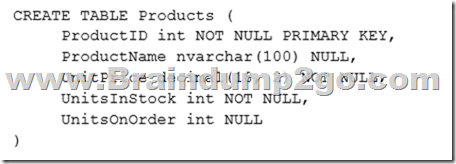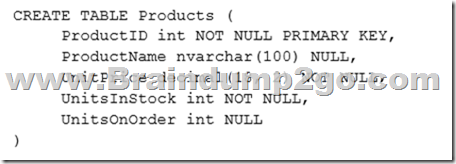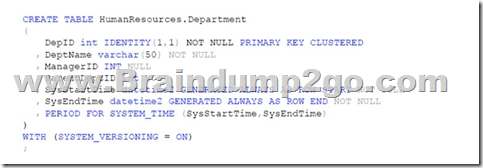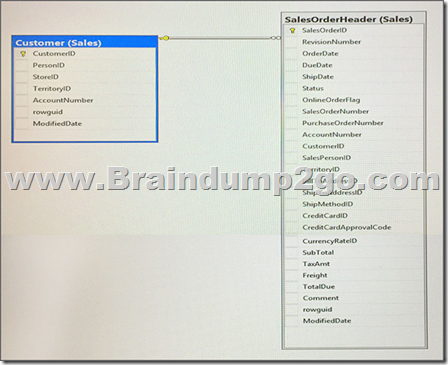10 02 2018
[New 70-761 Dumps!]100% Real 70-761 PDF Dumps 135Q-Braindump2go[98-108]
2018 February New Microsoft 70-761 Exam Dumps with PDF and VCE Free Updated Today! Following are some new 70-761 Real Exam Questions:
1.|2018 New 70-761 Exam Dumps (PDF & VCE) 135Q&As Download:
https://www.braindump2go.com/70-761.html
2.|2018 New 70-761 Exam Questions & Answers Download:
https://drive.google.com/drive/folders/0B75b5xYLjSSNZG9yTW9reVdkZG8?usp=sharing
QUESTION 98
Note: This question is part of a series of questions that present the same scenario. Each question in the series contains a unique solution that might meet the stated goals. Some question sets might have more than one correct solution, while others might not have a correct solution.
After you answer a question in this section. You will NOT be able to return to it. As a result, these questions will not appear in the review screen.
You have a table named Products that stores information about products your company sells. The table has a column named ListPrice that stores retail pricing information for products.
Some products are used only internally by the company. Records for these products are maintained in the Products table for inventory purposes. The price for each of these products is $0.00. Customers are not permitted to order these products.
You need to increase the list price for products that cost less than $100 by 10 percent. You must only increase pricing for products that customers are permitted to order.
Solution: You run the following Transact-SQL statement:

Does the solution meet the goal?
A. Yes
B. No
Answer: B
Explanation:
Products with a price of $0.00 would also be increased.
QUESTION 99
Note: This question is part of a series of questions that present the same scenario. Each question in the series contains a unique solution that might meet the stated goals. Some question sets might have more than one correct solution, while others might not have a correct solution.
After you answer a question in this section. You will NOT be able to return to it. As a result, these questions will not appear in the review screen.
You have a table named Products that stores information about products your company sells. The table has a column named ListPrice that stores retail pricing information for products.
Some products are used only internally by the company. Records for these products are maintained in the Products table for inventory purposes. The price for each of these products is $0.00. Customers are not permitted to order these products.
You need to increase the list price for products that cost less than $100 by 10 percent. You must only increase pricing for products that customers are permitted to order.
Solution: You run the following Transact-SQL statement:

Does the solution meet the goal?
A. Yes
B. No
Answer: B
Explanation:
Products with a price of $0.00 would also be increased.
QUESTION 100
Note: This question is part of a series of questions that present the same scenario. Each question in the series contains a unique solution that might meet the stated goals. Some question sets might have more than one correct solution, while others might not have a correct solution.
After you answer a question in this section. You will NOT be able to return to it. As a result, these questions will not appear in the review screen.
You have a table named Products that stores information about products your company sells. The table has a column named ListPrice that stores retail pricing information for products.
Some products are used only internally by the company. Records for these products are maintained in the Products table for inventory purposes. The price for each of these products is $0.00. Customers are not permitted to order these products.
You need to increase the list price for products that cost less than $100 by 10 percent. You must only increase pricing for products that customers are permitted to order.
Solution: You run the following Transact-SQL statement:

Does the solution meet the goal?
A. Yes
B. No
Answer: B
Explanation:
Products with a price between $0.00 and $100 will be increased, while products with a price of $0.00 would not be increased.
QUESTION 101
Note: This question is part of a series of questions that present the same scenario. Each question in the series contains a unique solution that might meet the stated goals. Some question sets might have more than one correct solution, while others might not have a correct solution.
After you answer a question in this section. You will NOT be able to return to it. As a result, these questions will not appear in the review screen.
You have a table that was created by running the following Transact-SQL statement:

The Products table includes the data shown in the following table:

TotalUnitPrice is calculated by using the following formula:
TotalUnitPrice = UnitPrice * (UnitsInStock + UnitsOnOrder)
You need to ensure that the value returned for TotalUnitPrice for ProductB is equal to 600.00.
Solution: You run the following Transact-SQL statement:

Does the solution meet the goal?
A. Yes
B. No
Answer: A
Explanation:
ISNULL ( check_expression , replacement_value )
Arguments:
check_expression
Is the expression to be checked for NULL. check_expression can be of any type.
replacement_value
Is the expression to be returned if check_expression is NULL. replacement_value must be of a type that is implicitly convertible to the type of check_expresssion.
References: https://docs.microsoft.com/en-us/sql/t-sql/functions/isnull-transact-sql
QUESTION 102
Note: This question is part of a series of questions that present the same scenario. Each question in the series contains a unique solution that might meet the stated goals. Some question sets might have more than one correct solution, while others might not have a correct solution.
After you answer a question in this section. You will NOT be able to return to it. As a result, these questions will not appear in the review screen.
You have a table that was created by running the following Transact-SQL statement:

The Products table includes the data shown in the following table:

TotalUnitPrice is calculated by using the following formula:
TotalUnitPrice = UnitPrice * (UnitsInStock + UnitsOnOrder)
You need to ensure that the value returned for TotalUnitPrice for ProductB is equal to 600.00.
Solution: You run the following Transact-SQL statement:

Does the solution meet the goal?
A. Yes
B. No
Answer: A
Explanation:
COALESCE evaluates the arguments in order and returns the current value of the first expression that initially does not evaluate to NULL.
References: https://docs.microsoft.com/en-us/sql/t-sql/language-elements/coalesce-transact-sql
QUESTION 103
Note: This question is part of a series of questions that present the same scenario. Each question in the series contains a unique solution that might meet the stated goals. Some question sets might have more than one correct solution, while others might not have a correct solution.
After you answer a question in this section. You will NOT be able to return to it. As a result, these questions will not appear in the review screen.
You have a table that was created by running the following Transact-SQL statement:

The Products table includes the data shown in the following table:

TotalUnitPrice is calculated by using the following formula:
TotalUnitPrice = UnitPrice * (UnitsInStock + UnitsOnOrder)
You need to ensure that the value returned for TotalUnitPrice for ProductB is equal to 600.00.
Solution: You run the following Transact-SQL statement:

Does the solution meet the goal?
A. Yes
B. No
Answer: B
Explanation:
The NULL value in the UnitsOnOrder field would cause a runtime error.
QUESTION 104
You have a database that stores information about server and application errors. The database contains the following table:
Servers

Errors

You need to return all unique error log messages and the server where the error occurs most often.
Which Transact-SQL statement should you run?
A. 
B. 
C. 
D. 
Answer: A
QUESTION 105
You have a database that includes the following tables.
HumanResources.Employee

Sales.SalesPerson

The HumanResources.Employee table has 2,500 rows, and the Sales.SalesPerson table has 2,000 rows.
You review the following Transact-SQL statement:

You need to determine the performance impact of the query.
How many times will a lookup occur on the primary key index on the Sales.SalesPerson table?
A. 200
B. 2,000
C. 2,500
D. 5,500
Answer: C
QUESTION 106
Hotspot Question
You have a table named HumanResources.Department that was created with the query shown in the exhibit. (Click the Exhibit button.)

You need to query temporal data in the table.
In the table below, identify the Transact-SQL segments that must be used to retrieve the appropriate data. NOTE: Make only one selection in each column.

Answer:

Explanation:
AS OF: Returns a table with a rows containing the values that were actual (current) at the specified point in time in the past.
CONTAINED IN: If you search for non-current row versions only, we recommend you to use CONTAINED IN as it works only with the history table and will yield the best query performance.
Incorrect Answers:
Not ALL: Returns the union of rows that belong to the current and the history table.
References: https://docs.microsoft.com/en-us/sql/relational-databases/tables/querying-data-in-a-system- versioned-temporal-table
QUESTION 107
You are building a stored procedure that will update data in a table named Table1 by using a complex query as the data source.
You need to ensure that the SELECT statement in the stored procedure meets the following requirements:
– Data being processed must be usable in several statements in the stored procedure.
– Data being processed must contain statistics.
What should you do?
A. Update Table1 by using a common table expression (CTE).
B. Insert the data into a temporary table, and then update Table1 from the temporary table.
C. Place the SELECT statement in a derived table, and then update Table1 by using a JOIN to the derived table.
D. Insert the data into a table variable, and then update Table1 from the table variable.
Answer: B
Explanation:
Temp Tables…
Are real materialized tables that exist in tempdb
Have dedicated stats generated by the engine
Can be indexed
Can have constraints
Persist for the life of the current CONNECTION
Can be referenced by other queries or subproce
Incorrect Answers:
A: CTEs do not have dedicated stats. They rely on stats on the underlying objects
C: Unlike a derived table, a CTE can be self-referencing and can be referenced multiple times in the same query.
References:
https://technet.microsoft.com/en-us/library/ms190766(v=sql.105).aspx https://dba.stackexchange.com/questions/13112/whats-the-difference-between-a-cte-and-a-temp-table
QUESTION 108
You have a database that includes the tables shown in the exhibit. (Click the exhibit button.)

You need to create a list of all customers and the date that the customer placed their last order. For customers who have not placed orders, you must substitute a zero for the order ID and 01/01/1990 for the date.
Which Transact-SQL statement should you run?
A. 
B. 
C. 
D. 
Answer: A
Explanation:
COALESCE evaluates the arguments in order and returns the current value of the first expression that initially does not evaluate to NULL.
References: https://docs.microsoft.com/en-us/sql/t-sql/language-elements/coalesce-transact-sql
!!!RECOMMEND!!!
1.|2018 New 70-761 Exam Dumps (PDF & VCE) 135Q&As Download:
https://www.braindump2go.com/70-761.html
2.|2018 New 70-761 Study Guide Video:
https://youtu.be/7Q-ah51thwA
[New-Exams]100% Valid 1Y0-203 PDF and VCE Dumps 85Q Provided by Braindump2go[56-66] [New 70-761 Dumps!]Braindump2go 70-761 PDF Exam Dumps 135Q for 100% Passing 70-761 Exam[98-108]
Comments are currently closed.